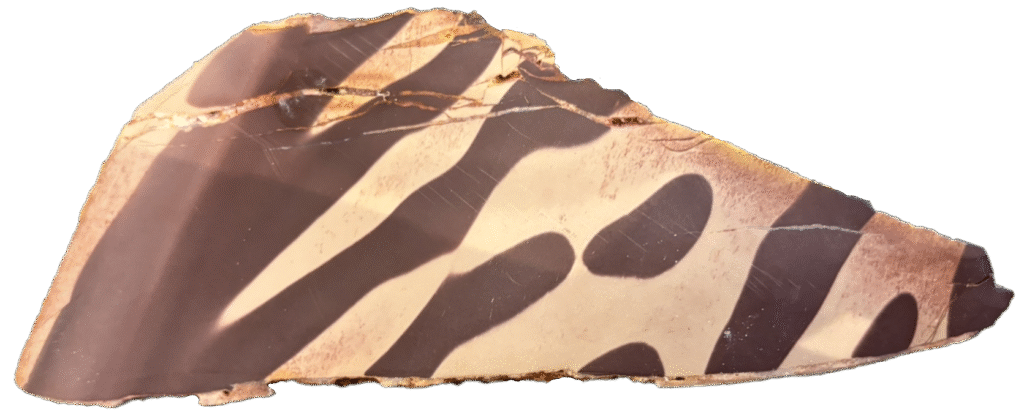
Zebra Rock, renowned for its dramatic streaks of cream and reddish-brown or black, is a unique sedimentary stone that has captivated geologists, collectors, and artisans for its rare beauty. With a history that stretches back over a billion years, Zebra Rock is celebrated for its striking patterns, symbolic meanings, and versatility. This comprehensive article explores its origins, composition, cultural significance, and spiritual connections.
Origins of Its Name and Alternate Names
The name “Zebra Rock” comes from its distinctive banding patterns, reminiscent of the stripes on a zebra. The term captures the natural artistry of the stone’s contrasting colours, which have become its signature.
Alternate names include “Zebra Stone,” “Striped Jasper,” and “Ribbon Stone,” though some of these names might refer to different stones with similar appearances. In Australia, where it is prominently found, it is simply referred to as Zebra Rock.
Composition and Physical Characteristics
Zebra Rock is a sedimentary stone composed primarily of fine-grained quartz and clay minerals, with the characteristic banding caused by alternating iron oxide-rich layers. These unique patterns formed over millions of years due to variations in mineral deposition during sedimentation.
Physical Characteristics and Varieties
- Appearance: Cream or light-grey background with reddish-brown or black stripes or spots, creating a zebra-like pattern.
- Lustre: Matte to slightly polished when worked, depending on the finish.
- Hardness: Measures about 5 on the Mohs scale, making it suitable for carving and ornamentation.
- Structure: Fine-grained and often compact, with intricate natural patterns.
Although Zebra Rock doesn’t have officially recognised varieties, specimens can differ in colour intensity, banding width, and complexity.
Geographical Locations
Zebra Rock is predominantly found in Australia, specifically in the East Kimberley region of Western Australia. It is often located in ancient riverbeds and sedimentary deposits. Some limited deposits of stones with zebra-like patterns have been found in other parts of the world, though the Australian variety remains the most famous.
Notable locations include:
- Lake Argyle, Australia: The primary and most renowned source of Zebra Rock.
- Mexico: Some striped jaspers are occasionally mistaken for Zebra Rock.
- India and Africa: Stones with similar banding patterns may appear, though they are geologically distinct from Australian Zebra Rock.
Historical Usage and Archaeological Finds
Zebra Rock holds a rich history connected to its Australian roots. Indigenous Australians have long appreciated the stone for its beauty and rarity, possibly using it in tools or ceremonial artefacts. While direct archaeological evidence of its ancient usage is rare, its prominence in traditional storytelling suggests a cultural connection.
In modern times, Zebra Rock has been widely used for jewellery, sculptures, and ornamental objects. Its visually striking patterns make it a favourite for artisans creating unique decorative pieces.
Interesting Facts
- Zebra Rock is estimated to be over 1.2 billion years old, making it one of the world’s most ancient stones with such intricate patterns.
- Despite its striking appearance, Zebra Rock is relatively soft compared to other stones, allowing for intricate carving and polishing.
- The Kimberley region in Australia hosts an annual Zebra Rock festival, celebrating this unique gemstone and its local significance.
Folklore, Superstition, Legends, and Tales
Indigenous legends surrounding Zebra Rock often regard it as a gift from the Dreamtime, the spiritual belief system of Australia’s Aboriginal peoples. Its patterns are thought to symbolise the interconnectedness of life, representing unity and balance.
In modern metaphysical lore, Zebra Rock is said to harmonise opposing forces, such as masculine and feminine energies or emotional and rational thinking. Some believe it serves as a grounding stone, offering stability in chaotic times and encouraging clarity in decision-making.
Its unique patterns are also seen as a reminder of individuality and personal growth, with each stripe symbolising life’s journey and experiences.
Mystical Healing Properties
Zebra Rock is valued in holistic and metaphysical practices for its grounding and balancing energy:
- Emotional Healing: Promotes inner harmony, emotional stability, and stress relief.
- Physical Healing: Believed to improve circulation, boost physical stamina, and support detoxification.
- Spiritual Healing: Encourages self-awareness, spiritual connection, and alignment of personal energy fields.
Astrological Links and the Chakra System
Zebra Rock is connected to multiple chakras and astrological signs, making it a versatile gemstone:
- Root Chakra: Its grounding energy resonates deeply with the Root Chakra, fostering stability, security, and a sense of belonging.
- Crown Chakra: The contrasting stripes symbolise higher balance, aligning with the Crown Chakra to enhance spiritual awareness and personal growth.
- Sacral Chakra: The reddish tones found in Zebra Rock energise the Sacral Chakra, stimulating creativity and passion.
Astrologically, Zebra Rock resonates with Virgo, supporting clarity and organisation, and Capricorn, enhancing focus and determination. It also aligns with Pisces, promoting a deeper understanding of interconnectedness.
Use as a Birthstone and Wedding Anniversary Gift
Although not an official birthstone, Zebra Rock is often chosen as a symbolic stone for those seeking balance and creativity.
As a wedding anniversary gift, Zebra Rock represents the harmony and unity of opposites, making it an ideal gesture for couples celebrating their enduring partnership.

Zebra rock
Zebra Rock is a sedimentary stone composed primarily of fine-grained quartz and clay minerals
